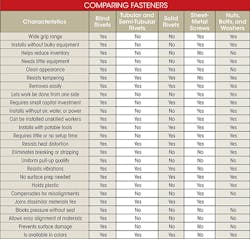Bolts and Machine Screws
Nuts, bolts, and machine screws are the most common fasteners used for thin joints, despite the ongoing development of other fastener types. One reason for their popularity is that they are come in a wide range of types and sizes. Over 500,000 standard versions are commercially available, as well as innumerable custom and special versions.
Bolts and machine screws are also the primary choice for joints that require subsequent disassembly and reassembly. Other fastener types meet this requirement, including spring clips, but they do not provide the same structural strength.
Threaded fasteners do suffer from loosening after assembly, particularly when subjected to severe vibrations. Fasteners with intentionally deformed threads combat such loosening, but they cost a little more than standard fasteners and significantly increase installation time. And the self-locking threads on the fasteners are no longer self-locking if the fasteners are re-used.
For a given fastener size, joint shear strength is highest for bolts and machine screws and successively lower for tapping screws, conventional rivets, and blind rivets. However, even with blind rivets, the joint material usually fails before the fastener.
Assembling nut-and-bolt joints is relatively slow, even when workers use power tools. In some applications, assembly times can be cut by using push-on fasteners instead of conventional nuts. Push-ons also prevent loosening; however, they are limited to relatively light tensile loads.
Perhaps the most serious limitation of nuts and bolts is the need for access to the back of the joint whenever a nut is used. This limitation does not apply to machine screws that engage threads in the joint elements, but joints thinner than 1/8-in. may not provide enough thread engagement to properly hold a machine screw.
For some applications, threaded inserts solve both the access and thread-engagement problems. Some inserts get welded to the base component, but this is a time-consuming technique, and heat can distort parts and damage finishes. A better alternative to welding is to install self-clinching inserts, most commonly in the form of nuts pressed into suitably sized holes. Such inserts are also available as stand-off and male studs. A typical self-clinching nut that provides a 1/4-in. thread in 1/16 to 1/8-in. cold-rolled steel has a push-out strength of 600 lb and a torque strength of 160 lb-in.
Tapping Screws
There are two broad categories of tapping screws: thread-forming and thread-cutting. Both make their own threads when driven into properly sized pre-formed holes. Some pierce or drill their own holes, eliminating a separate hole-forming operation, and some have built-in washers to add more bearing or sealing surfaces.
Tapping screws are suitable for a wide range of materials and thicknesses. They work on sheet metal, structural steel, brass, bronze, zinc, aluminum, polyamides, polycarbonates, and wood, in thicknesses ranging from 0.02 to 0.50 in.
For a given size, tapping screws cost less than nuts and bolts or machine screws, but more than conventional and blind rivets. Tapping screws can be installed manually or with power tools. However, installation is inherently time-consuming, especially when hard materials such as stainless steel demand high driving torques.
It can be difficult to maintain consistent torque from tapping screw to tapping screw because of variations in material strength and thickness. These torque variations result in the screws having a wide range of strengths. In addition, overtorquing can strip out the self-formed threads, particularly in soft materials such as aluminum and plastic, or in joints less than 0.04-in. thick. Stripped threads, common in ductwork, waste time and require a supply of oversized replacement screws.
Tapping screws do not require access to the back side of the joint, but in joints up to 0.06-in. thick, the screw must project as much as 3/8 to 5/8 in. beyond the back of the joint to ensure acceptable fastening strength. In some applications, the lack of backup space eliminates tapping screws as a fastening option.
Some tapping screws use a self-swaging action to resist loosening due to vibrations. However, loosening can still be a problem in metal 16-gauge (0.0579-in.) and thinner.
Conventional Rivets
Conventional rivets, like nuts and bolts, are available in a wide variety of standard types, sizes, and materials. Variants include solid, tubular, semitubular, bifurcated, and two-piece rivets. Two-pieced versions are installed where one-piece rivets would split, craze, or crack materials like wood and plastics. Tools and machine for setting conventional rivers run the gamut from simple hand tools to advanced, fully automated robots.
Rivets have excellent vibration resistance. Unfortunately, this makes disassembly and reassembly difficult.
Perhaps the primary limitation of conventional rivets is that the back of the joint must be accessible for bucking during installation. In many cases, such access is only accomplished by drilling an access hole.
Blind Rivets
There are two types of blind rivets: pull-mandrel and dive pin. Both types come in a wide variety of sizes, materials, and variations.
Pull-mandrel rivets can have hollow cores, solid cores with open ends, or vapor-tight solid cores with closed ends. For a given rivet length, they have a wide grip range, (the thickness of material they can fasten). Engineers can choose from a long list of rivet and mandrel materials.
Drive-pin rivets have a pin protruding from the head. Workers install them by driving the pin down with hammer, expanding the shank against the blind side of the joint. Installation requires no special tools, but the materials must be rigid enough to withstand hammer blows.
Both types of blind rivets can be installed easily in five seconds or less, and there’s no need to access the back of the joint. Installation tools are relatively simple and inexpensive.
Blind rivets are not as strong as nuts and bolts. However, they have adequate strength for thin joints and resist vibrations better than tapping screws and nuts and bolts.
Blind rivets can be installed in blind holes in plywood, composition board, and some plastics. The limiting criterion is the ability of the material to withstand rivet expansion without fracturing. In through-fastening applications, blind rivets require a minimum of back-up space. About 0.15 in. is needed for 1/8-in. diameter rivet, less for smaller sizes. Blind rivets do not permit easy disassembly. However, several types are easy to drill out and replace.
Choosing the Right Fastener
There are no simple rules for determining which are the best fasteners for a given thin-walled application. But answering the following eight questions can give design teams solid grounds for a good decision.
- After original assembly, will the joint ever be taken apart and put back together for maintenance or access to other parts? If so, tapping screws or nuts and bolts are almost certainly the best choices.
- Will the joint experience shock or vibrations? If so, either conventional or blind rivers are probably needed, and tapping screws are eliminated.
- What strength is needed? Nuts and bolts provide the most tensile and shear strength, followed in order of decreasing strength by conventional rivets, tapping screws, and blind rivets. Nuts and bolts are also best at resisting twisting. If the joint material is thin or soft, and if resistance to loosening is a requirement, blind rivets should be used.
- Can joint components be brought to an assembly machine, or is it necessary to bring the tool to the work? If the tools must go to the work, blind rivets are likely the best choice.
- Is the back of the joint accessible? If so, conventional rivets and nuts and bolts are acceptable. If not, blind rivets or tapping screws must be used. And how far is the fastener’s hole from the edge of the joint? Distances of more than 6 to 12 inches probably preclude the use of conventional riveting machines.
- If the application calls for a blind fastener, how much backup space is available? Less than 0.225 in. of space dictates a blind rivet; more space allows use of tapping screws.
- Can any of the fastener candidates have special features that might be important for the application? For example, some blind rivets and screws are self-sealing, and most rivets can be prefinished to blend with joint colors.
- If all other factors are equal, which fastener leads to the lowest in-place cost? In some instances, the decision is simple. For example, if a second worker is needed to buck a conventional rivet from the back, then installing a blind rivet will cost less. Other applications required in-depth analysis. For example, the capital investment needed to set up an automated riveting machine may not be justified for short runs.

